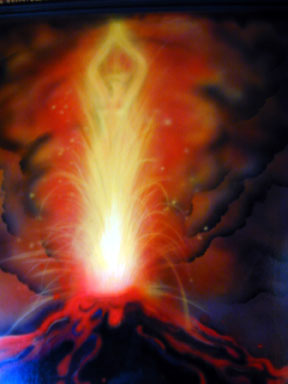PROJECT
COMMON
GROUND
Bringing the best of ancient culture forward to
meet the best of current culture

Who we are
The residents of Kauai and, specifically, those who dwell in the Moloaa/
Waipake watershed, are in a position to be part of something exceptionally
positive�for the aina, the Hawaiian culture, and all the people living
and visiting here. In association with the Benefit Network, a 501(c)3
non-profit tax-deductible charitable/educational trust, this is a proposal
whose time has come. It's the united brainstorm of a growing collective
of residents who are committed to sustainability as a way of life, at
a time when self-sufficiency is becoming the only hope of island survival.
This alliance of concerned people represents a resourceful cross section
of the population who has already initiated many positive undertakings
for the community. Some of these include sponsoring an informal community
center that serves a wide variety of community needs, alternative energy
projects, a local barter system, permaculture courses, a cooperative home
school, citizen's watershed councils, an ahupuaa conference, an association
of health facilitators, and the manifestation of a large round community
tent called the Aloha Lodge. This lodge, dedicated by the Hopi Elder whose
vision was the inspiration for it, is symbolically significant as a place
where all the peoples of the rainbow can come together and remember how
to sing in harmony.
Proposal Summary

The
Proposal --Why
A large part of the Moloaa River, an exceptionally beautiful rural area
of Kauai, and some adjacent land has recently been offered for sale.
There are still some parcels available that are conducive to the establishment
of an environmentally sound community center and eco-village, including
large sustainable community gardens. Most of the river land went into
escrow before it even hit the market. The status and plans for those
river parcels are currently unknown, but we do know that large subdivisions
and developments are popping up all over the island at an alarming rate.
As floods of people seek to own a piece of paradise, Kauai is experiencing
an overwhelming bout of land development as we approach the millennium.
Much of the existing development is quite excessive and less than sustainable.
The rivers are the lifeblood of any land and the people who live there. In ancient Hawaii, people lived cooperatively in land divisions known as Ahupuaa, the watershed area extending from the mountain to the sea. This was an effective lifestyle for sustaining many people (far more than today) and caring for the aina in a way that assured abundance for everyone including the future generations. This project is a step towards the re-establishment of a cooperative sustainable lifestyle that is at once both ancient and modern, and based on principles that are tried and true. We think projects like this are crucial for survival of the island's ecosystems, the current residents and certainly for future generations.
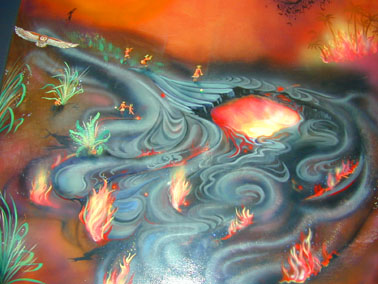
What...
What made it work then, and what will work again is cooperation�land
held in common stewardship. Project Common Ground is mapping a path
to this cooperative village reality. We are proposing to acquire this
land as a community project and be co-stewards of it in a way that sets
an example of true sustainability and peaceful cooperation of everyone.
Hawaii is presently experiencing a very interesting transition and we
intend to support the effort of sovereignty by demonstrating how one
community, defined by bioregion, can take responsibility to provide
for all its real needs such as food, clean water and energy.
Throughout
this proposal, when we use the term 'community,' we're meaning it in
every sense of the word. It's our intention to create community that
integrates not only residents, but also neighbors and the larger island
community as well. It's also our intention to align ourselves with a
growing worldwide movement of "leaderful" organizations. In other words,
we will structure ourselves in a way that promotes equal and shared
responsibility, rather than the more conventional pyramid structure
of leadership. As this way embodies a growing consciousness, there's
plenty of people and literature to assist us in the process of learning
this positive new and yet old way.
The priority of this multi-faceted
proposal is the creation of a community center to serve the needs of
the residents of the rural Moloaa area and, to an extent, the larger
island community and even a certain amount of visitors. Public community
facilities and gardens, residential eco-village, and land restoration
and reforestation are the main focal points of the plan. Our intention
is to provide for every aspect of the community's needs including a
community nursery and gardens, a gathering space for meetings and events,
an educational and recreational space for youth, library, arts and crafts,
a community wellness clinic, and an agricultural grange hall which encompasses
a farmer's coop, processing center, and compost center. It will all
be run by alternative energy and, as it progresses, will become a hub
of innovative projects both useful and educational.
This is a model
eco-village that honors the land first and the culture and spiritual
practices of all people in order to demonstrate a simple, sustainable
and respectful way of life. The focus of this endeavor is to benefit
the island's youth and to cooperatively discover what it is that can
bring diverse people together for a common good. We plan to support
the efforts of the Moloaa Watershed Council, encouraging the restoration
and stewardship of the river as a cooperative and educational effort
of neighbors and friends.

One 90-acre parcel, as previously mentioned, is now being sold at a
cost of $2.6 million. The acreage is zoned open, which means as many
as18 structures may be built on this piece without subdividing. This
parcel would be an excellent location for this plan, and yet there are
other places that would also work. There are still possibilities of
riparian land available that would be prime for restoration projects,
and potentially less expensive. We need to be flexible because of the
current speed that land is being sold here on Kauai.
Our focus now is
the generation of income in order to secure a suitable location. Eventually
we envision being part of an island-wide network of similar projects.
Because of our enthusiasm to create a shared leadership foundation,
we're intending to finance the project with tax-deductible donations,
and/or the private contributions of people with strictly altruistic
motives. Our first priority regarding funding is to secure the land.
Further research and development will be needed in order to make specific
quotes regarding costs of building. We project that $50,000.00 would
be a good start for research and development with the goal of manifesting
approved architectural and agricultural drawings and designs, as well
as the formation of solid social, organizational and financial structures.
A large central community structure, perhaps a geodesic dome, will be
the heart of the village. This space, being round, would be conducive
to the circular meetings of equals, as well as a central meditation
hall or music center. This structure would be surrounded by long houses,
in a flower petal configuration, that would accommodate common kitchen
facilities, bathrooms, dining and living areas, craft and music room,
greenhouse, exercise and healing rooms, etc. Surrounding this structure
would be simple huts built of local sustainable materials such as bamboo.
The essential concept of Project Common Ground is to make everything,
from the construction of houses to the growth of self-sustaining farms,
an educational and cooperative venture of sustainable techniques. With
utilization of innovative building and community design and creative
(edible, medicinal, and useful) landscaping, the possibilities of accomplishing
our highest aspirations are boundless. The construction projects that
will be the community/learning center and farm co-op will all be cooperative
educational projects. We would like to build them according to the ancient
Hawaiian tradition of long houses. This will take some research to find
out who can teach this process and how we can fit into all necessary
building codes.
General estimates to develop and restore land to be
excellent for organic farming run from $5-20,000 per acre. We feel by
using simple permaculture techniques our costs will be much less than
$5,000. We will start small, with zone 1 gardens and expand the farm,
(edible landscaping), as we go. Our larger focus will be on reforestation
with native and edible species. Some of our costs can be deferred by
turning the construction of buildings with renewable resources and alternative
energy into educational courses and community functions.
The Cost
Recently it was announced on both CNN and the Oprah Winfrey Show that
Kauai is the safest place in the USA to live. In light of the already
booming population explosion of both tourists and new residents, this
presents the tiny island of Kauai with an epic problem. Development
to accommodate this growing number of people is eating away our agricultural
land and seriously compromising our ability to create sustenance.
Today, roughly 97% of food consumed on Kauai is imported. In the case
of an emergency, such as a hurricane, shipping strike or Y2K this poses
a major island-wide problem. In such an instance, Kauai would certainly
not be the safest place to live. Chaos would likely be a more appropriate
term.
Roughly 99% of our energy is also imported in the form of petroleum
and natural gas that makes us further dependent. Virtually all the surface
water and much of the underground waters are contaminated by non-source
pollutants such as runoff from chemical farms and viruses from livestock.
Our coral reefs are dying due to erosion and runoff from deforestation,
chemical farming, and livestock grazing.
Health care is another major expense for many people due to costly prescriptions
and medical practices that give most of the responsibility to highly
trained professionals. The majority of residents in Kauai suffer financially
due to our dependency on costly imported and non-sustainable products,
many of which are also unhealthy. Our future is unstable because our
children are not being taught sustainable living skills in the school
system. Most importantly our youth need to experience positive alternatives
to the dominant system that often edifies discrimination, conflict,
and competition as a way to get along in the world. The opportunities
we offer to our children could certainly be more excellent, as anyone
knows who's paying attention to the problems of our youth.
Needs Assessment
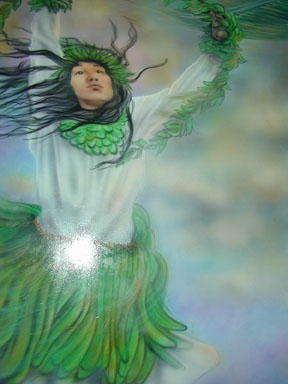
Objectives
Project Common Ground knows that a wealth of manao (wisdom) exists in
the common hands of many of the island's exceptional residents. Project
Common Ground will create a functional model of total sustainability.
We intend to construct organic permaculture gardens that will provide
enough food for everyone in the watershed as well as a surplus for market.
The eco-village will create its own energy with renewable alternative
technology, such as solar, wind, biomass and hydropower. Our emphasis
is on low-tech and affordable methods that can be easily shared with
the community. Our cooperative river restoration project will ensure
water quality through 1) researching the problems and 2) designing and
implementing positive solutions including restoring the flow of water,
clearing the rivers of invader species, replanting native species and
education to change out-dated practices.
Our agricultural plan will emphasize reforestation, especially of native
species, in order to restore the delicate balance of ecology. Reforestation
will help restore the reefs and rivers by causing more rain and helping
the land to absorb more, while slowing down the runoff and filtering
silt along the way. This will help rejuvenate algae, fish and plant
life in the rivers and reef, and restore vitality to the soil.
Learning about and eating fresh, whole, organically grown food can gain
us more self-responsible health care, as well as becoming educated about
herbs and medicines that can be grown and harvested locally.
By emphasizing Hawaiian culture and crafts, such as weaving, basketry,
kapa (cloth) making, food processing, and other living skills, we'll
be increasing our creativity as well as our ability to function in harmony
with the aina. The results of this project will create more abundance
for everyone because it will demonstrate how all of our needs from food
to medicine to energy can be met with creativity, and local renewable
resources. We are also involved in implementing a local barter system
called Kauai Coconut Currency.
Every aspect of Project Common Ground is an educational opportunity
for the youth as well as for all residents and interested people. Our
emphasis, by far, is to do everything for and with the youth, with an
ultimate goal of being a sanctuary and home for youth in need. A learning
center will be a main concern of this project in order to teach and
share sustainable living skills. We all have a lot to learn and plenty
to teach. A life of harmony with the earth is a life of dignity. Through
instilling these values in the next generations we ensure a sustainable
future for all.
Method
We're
currently in the process of setting ourselves up as a Conservation Land
Trust. The Trustees will all be respected community Kapunas (elders)
and leaders. The Beneficiaries are the Future Generations Forever. As
Hawaii becomes a respected Nation among Nations, we are designing a
lifestyle that is harmonious with the laws of Nature. We'll focus our
efforts on sustainable restoration of the watershed and cooperation
of all the diverse people involved.
Our plan is to establish voluntary councils of those interested in being
part of this adventure. Kapunas, youth, friends and neighbors, agriculture
and restoration consultants, health facilitators, cultural, historical
and community advisors, residential stewards, etc�councils such as these
will form the governing bodies. Everybody will have an equal vote, and
decisions will be made by consensus, thus requiring us to learn well
the art of cooperation. Each council will have its own area of responsibility
and there will be a central council where all councils will be represented.
All Central Council meetings will be open and conducted Fish Bowl style,
where everyone can hear and can speak through their representatives.
The 2-D design of this council plan looks like a Flower of Life, a sacred
geometrical pattern of interlocking circles. We're aware that this process
of decision making is other than what most of us are used to, and yet
we believe in it so strongly that we're willing to take the necessary
steps to deprogram and learn a brave new way. It may seem cumbersome
at first, but there are techniques to learn and practice that will make
it easier and more efficient. This is a path worthy of exploration.
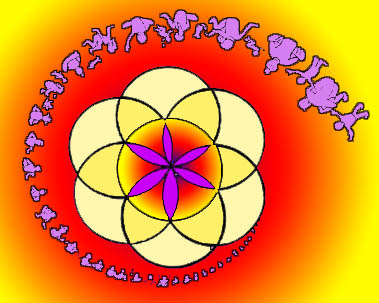
Decision Making by Council
Land
Plan
We hope to work cooperatively with everyone who holds private land along
the river, for the health and restoration of the river and the highest
good of all. Originally, we hoped to acquire all the river land as common
land. The fact that it is being sold so quickly demonstrates further how
critical is the problem and also our need to create positive
sustainable solutions immediately. We will encourage positive interaction
of all neighbors and cooperation in the local watershed
council. We would love to include not only regeneration of the
actual river but also renewal of the tried and true farming techniques
such as the auwai and loi system, (ditch irrigation, terraces and taro
patches). This is truly an opportunity for significant progress in our
human quest for unity. As we make the land more whole, so too we make
ourselves more whole.
* Education of the Aina like identification,
re-establishment
* Alternative Energy
* Proper food preparation, cleanliness
and health procedures
* Renewable, sustainable and native
building materials and
* Natural health practices; first aid and survival
* Personal and bioregional ecology
* Parenting, co-parenting, child-development
* Traditional culture of Kauai such as spiritual
co-existence
Everyone will benefit from sharing the responsibility of land and river
stewardship. If we get the 90-acre parcel, we'll also be caretakers of
a very abundant well. By working in cooperation and nurturing compassion
for our neighbors, everyone will be able to meet their water needs and
no one will be left high and dry. We can grow enough food for everyone
in the watershed and plenty more, too. We'll become richer for the experience
of learning how to cooperate with each other. We'll become wiser by learning
the lessons of the aina and the system of the ahupuaa. The ancestors,
past and future, will be pleased with us for honoring the past and providing
for the future. If every watershed around the island comes together in
a similar way, the whole island will experience abundance and peace. We
would do well to remember that Kauai is a powerful place on the planet,
and when we act in extremely positive ways, we cause positive vibrations
to ripple out for the whole world to share. We can be honest and acknowledge
that great injustices have occurred in this watershed. Probably most watersheds
in the world have experienced similar trauma at this point. Healing will
begin when we decide we want to make it right for all who've suffered
and then agree that the ultimate goal now is peace for everyone. What's
past is past and what's possible now is what matters.
* Circle governance skills like facilitation,
mediation and
communication
and use of native plants, organic restoration methods, natural
and native farming techniques, etc.
techniques
with the aina, astronomy, navigation, farming, canoe building,
music, hula, medicine,
etc.
Benefits for Community
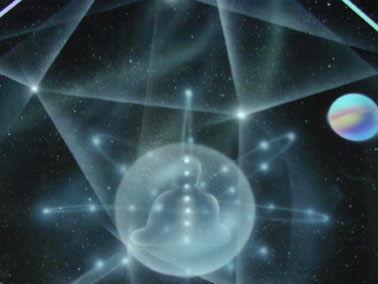
A fundamental part of the eco-village project will be the Moloaa/Waipake Community Center. The Community Center will be constructed according to, and made available to meet the needs of the community. One aspect can be a Farmer's Co-op, which will include a meeting space, educational projects and a place where organic resources can be generated, stored and shared.
The project will provide an assembly space for such things as Watershed--Ahupuaa--Council Meetings, Cultural Events, Cooperative Home School, After-School Youth Programs, Recreation, and fun Neighborhood Gatherings. All courses offered for the training of residential stewards will also be available for the whole island community to participate in. A great advantage for the community is the strong network of health facilitators who are motivated to create a community wellness center for the benefit of the community's education and self-sufficient health care. This will be a very important aspect of the community project. One advantage of the eco-village is to provide a working model of a sustainable community. Another advantage of the eco-village for the larger community is to provide a base of facilitators on many levels, including restoration workers, farmers, program coordinators, educators, and community facilitators.
Evaluation
Periodic evaluation by both the internal and larger community is important. Voluntary community participation and input will be welcomed and encouraged, according to the council plan. Community outreach in the form of questionnaires and public meetings will happen regularly. In addition, approval by the community will be evidenced by attendance of events, courses and cooperative projects, as well as in the marketplace.
Sustainability of Project Common Ground
(Future funding)
There are boundless opportunities for a project like this to be self-sufficient, once it gets started. Market agriculture (edible and medicinal) and production of organic resources such as compost and mulch are obvious sources of abundance as well as beneficial for the community.
Cottage crafts made from locally grown plants can be both income and education that encourages Hawaiian culture (weaving, kapa, dyes, musical instruments and other arts). Alternative energy, renewable building materials and innovative water technology are a natural result of imaginative people living together and stimulating each other's creativity, and offer opportunities to sell products as well as offer courses for tuition costs. These are areas of great interest among the larger community and can create prosperity all around.
It's important to us that local residents are able to attend courses they're interested in at a cost they can afford, or for work trade.
A natural health care facility including both a school and clinic would greatly benefit the island (sliding scale for residents) and help support Project Common Ground too, on many levels. Perhaps the most exciting avenue of abundance we can explore is education. Courses of the cultural and sustainable living arts can be offered by and for Kauai residents by donation or work trade. These same courses are sources of great abundance if offered to visitors from afar. Scientists, environmentalists, students, teachers, artists, naturalists, herbalists, organic farmers, and global village net workers are a significant untapped tourist market.
Knowledge shared increases exponentially on every level. The whole island stands to gain great collective wisdom by sharing seminars in this way. This wisdom is an even greater gain for the community than money. It is the heart of genuine sustainability.
Along these lines is an opportunity to create abundance by renting integrative ecological cabins to visitors, who would appreciate such a unique experience. Having visitor space available is also a good way to show appreciation for people who help to fund the project by making tax-deductible donations.
In addition to seminars, benefits and cultural events, educational materials can be produced and marketed, such as videos, books, and tapes about our projects that will be both income and an opportunity to share and inspire more people to do similar projects in their own neighborhood.
Benefit Network for Project Common Ground
Fiscal Sponsor, Benefit Network President and Executive Director
Barbara Peck
Address: P.O. Box 1197, Hanalei, HI 96714
Phone: (808) 245-0518
Project Common Ground Program Coordinator
Christopher Postoloff
